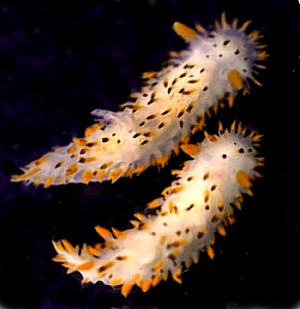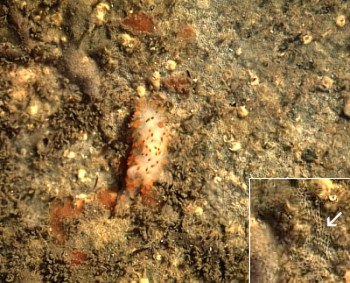

Crimora coneja
Marcus, 1961
Order: NUDIBRANCHIA
Suborder: DORIDINA
Superfamily: ANADORIDOIDEA
Family: Polyceridae
Subfamily: Triophinae
DISTRIBUTION
Point Loma, San Diego, California to Cape Arago, Oregon, USA.
PHOTO
UPPER: Rocky intertidal at Punta Gorda, northern California, USA.
LOWER: C. coneja on its bryozoan prey, Hincksina minuscula, on the underside of an intertidal cobble at Cape Arago, Oregon, USA. The light colored patches (see inset) have already been grazed by the nudibranch.
PHOTOS: Jeff Goddard.
Crimora coneja is a delicate and rarely seen dorid nudibranch with orange rhinophores, white gills, and pointed, orange and brown tipped dorsal papillae, some of which have forked tips. Specimens can reach 23 mm in length.
It is known from Point Loma, San Diego, California to Cape Arago, Oregon. However, it has been reported from only two localities between these two sites: (1) in the rocky intertidal at Punta Gorda in northern California (Goddard, 1987), and (2) subtidally on rocks just inside the mouth of Morro Bay in central California (Mike Behrens, personal communication, June 2000). Crimora coneja has been found in abundance only once, in May 1984 at Punta Gorda, when 66 specimens were found on a single low tide. In the northern part of its range Crimora coneja preys exclusively on the thinly encrusting bryozoan Hincksina minuscula, which is usually found in cryptic habitats on the undersides of loose rocks and in small holes and crevices. Its prey at Point Loma is unknown. It uses its radula to rasp entire zooids out of their minute calcified compartments, leaving behind the lacey white skeleton of the bryozoan.
The egg mass is a thin white ribbon laid flat, rather than on edge like most other dorid nudibranchs. Planktotrophic veliger larvae hatch from these egg masses after 10 days at 12 to 16 deg C (Goddard, unpublished observations) and 17 days at 10 to 14 deg C (Goddard, 1984).
In both form and color, Crimora coneja superficially resemble Triopha catalinae (Cooper, 1863) and, to a lesser degree, Laila cockerelli MacFarland, 1905. Why Crimora coneja has not been found at more localities in California is something of a mystery. The nature of its distribution may parallel that of Crimora papillata Alder & Hancock, 1862, long considered one of the rarest north Atlantic nudibranchs until being found in abundance in specific subtidal habitats (Thompson & Brown, 1984).
References:
• Goddard, J.H.R. (1984) The opisthobranchs of Cape Arago, Oregon, with notes on their biology and a summary of benthic opisthobranchs known from Oregon. The Veliger, 27(2):143-163.
• Goddard, J.H.R. (1987) Observations on the opisthobranch mollusks of Punta Gorda, California, with notes on the distribution and biology of Crimora coneja. The Veliger, 29(3): 267-273.
• Goddard, J.H.R. (1998) A summary of the prey of nudibranch molluscs from Cape Arago, Oregon. Opisthobranch Newsletter, 24: 1-14.
• Thompson, T. E. & G. H. Brown. (1984) Biology of opisthobranch molluscs, Vol. II. Ray Society: London.
[Prepared by Jeff Goddard]
Goddard, J.H.R., 2000 (June 19) Crimora coneja Marcus, 1961. [In] Sea Slug Forum. Australian Museum, Sydney. Available from http://www.seaslugforum.net/factsheet/crimcone
Related messages
-
Crimora coneja from Point Loma, California
From: Jeff Goddard, July 13, 2005 -
Crimora coneja from California & Oregon
From: Jeff Goddard, June 20, 2000
